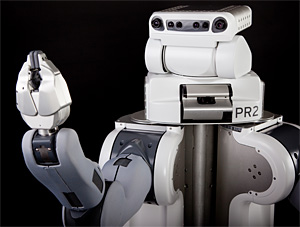Kitchen lighting is undergoing a transformation as well, says Daniel Tripp, a product manager at the U.S. subsidiary of German high-end kitchen hardware and fixture manufacturer Hafele. Rows of tiny LED lights can be embedded in any surface so that countertops, backsplashes, and cabinets can be set to glow at any brightness or in any color. Task and mood lighting in the kitchen can then be customized to a variety of moods or functions, and increase visibility into normally hidden spaces such as bottom cabinets. Lights can be programmed to address the different needs of all the various people using the future kitchen, with extra-bright lighting for the elderly, soothing lighting for midnight snackers, colorful lights for toddlers, or even full-spectrum white light for those subject to depression in the winter. Tiny embedded sensors and cameras, Tripp adds, could serve to track what food you’re running out of in the refrigerator, or to function as triggers to automatically open cabinet doors or trash bins when you reach toward them with your hands full.

Meet the Jetsons
Also coming to kitchens: robots. A company called Willow Garage in Menlo Park, California, already sells a home robot that can cook a complete breakfast and perform various other household chores. Right now the robot, known as Personal Robot 2 (PR2), costs $400,000, and is intended only for robotics researchers, notes Willow CEO Steve Cousins. “But the price will come down, and its functionality will improve to the point where people will be willing to pay for it,” he says. We may well see affordable robots able to help out with the cooking and cleaning within 20 years. In the meantime, we’ll see more and more small-scale robotic devices capable of performing a single, relatively simple chore, such as stirring and monitoring the temperature of a dish that’s cooking on the stove, or wheeling a tray full of food around to guests. RoboDynamics, in Santa Monica, is already selling a $3,000 tray-toting robot called Luna.
And yes, appliances are still an important part of the kitchen of the future. At today’s leading edge are “speed ovens” from GE, Miele, Electrolux, and others (at prices starting around $1,800) that combine bursts of heat and microwave energy in ever-more-sophisticated ways to turn out food that’s indistinguishable from food prepared in conventional ovens, but in one-third the time. “It zaps and bakes a fabulous, juicy bird in 20 minutes,” says Kinoshita Mann, who is putting a Miele version (the Europa MasterChef 60cm Speed Oven) in her kitchen, where she’s test-driving many of the appliances and concepts for her clients’ kitchens. Researchers are already looking at technologies that can enlist intense pressures or even laser beams to further reduce cooking times without compromising food quality. And as one sign of how seriously appliance makers already take the growth of consumer interest in wellness, GE is at pains to stress that its latest line of refrigerators boasts chilling drawers and twin evaporators to keep produce fresh, plus hot and cold water filters that supposedly remove 98 percent of the impurities often found in tap water.
But for all the new appliances and improvements coming into the kitchen of the future, Kinoshita Mann is most excited—if a bit nervous—about one appliance she’s leaving out of her own kitchen. “All the food garbage is going to go into a small, built-in composting machine for the garden,” she says. “It can process 5 pounds of stuff a day, including meat. No garbage disposal—gulp.”
No one ever said the future isn’t a little scary.
David H. Freedman is a science and technology journalist and author, who writes for The Atlantic, The New York Times, and Discover magazine, for which he writes the Impatient Futurist column. His most recent book is Wrong: Why Experts Keep Failing Us. This is his first article for Gourmet Live.


 Pinterest
Pinterest


